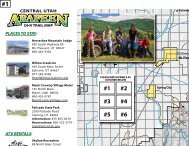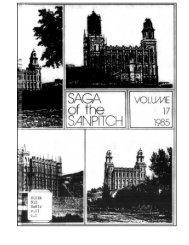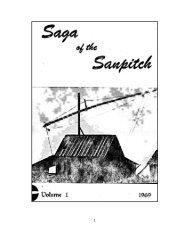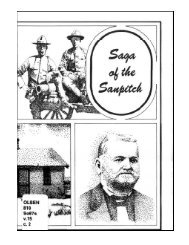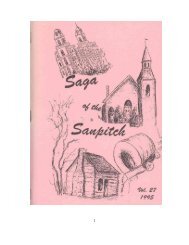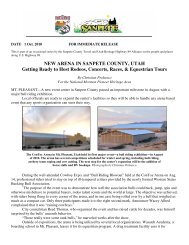Saga of the Sanpitch Volume 13, 1981 - Sanpete County
Saga of the Sanpitch Volume 13, 1981 - Sanpete County
Saga of the Sanpitch Volume 13, 1981 - Sanpete County
- TAGS
- saga
- sanpitch
- volume
- sanpete
- sanpete.com
Create successful ePaper yourself
Turn your PDF publications into a flip-book with our unique Google optimized e-Paper software.
Early traveling was done with a team <strong>of</strong> horses and a wagon or with a horse and buggy. In <strong>the</strong> 1920's<br />
<strong>the</strong> Model T Ford came into use. This was followed by modern cars and an increase from <strong>the</strong> twenty or<br />
twenty-five mile speed limit to seventy miles, <strong>the</strong>n back to <strong>the</strong> fifty-five mile-per-hour limit.<br />
Perhaps <strong>the</strong> first routes from <strong>the</strong> pioneer homes led up through Fairview, past <strong>the</strong> Indianola flats into<br />
Salt Lake City by wagon team to <strong>the</strong> Endowment House for performance <strong>of</strong> marriages. That early generation<br />
also traveled southward to Manti and to St. George, at <strong>the</strong> extreme sou<strong>the</strong>rn end <strong>of</strong> <strong>the</strong> state, to help erect<br />
<strong>the</strong> temples <strong>the</strong>re. Later, many <strong>of</strong> <strong>the</strong>m went by horse and buggy to <strong>the</strong>se temples to be married.<br />
The wagon ruts or a one-horse track went to many places within <strong>the</strong> county. The first generation<br />
traveled east and west <strong>of</strong> <strong>the</strong> small towns and found farmland, covered with sagebrush, to be homesteaded, a<br />
place where <strong>the</strong>y could build a log cabin, plant grain, alfalfa and potatoes...places like "Manasseh,"<br />
"Johnstown," and "The Farm," close to <strong>the</strong> hills. O<strong>the</strong>rs in this generation bought farm lands and toiled from<br />
daylight to dark to make <strong>the</strong> lands produce food for <strong>the</strong>ir livestock and a living for <strong>the</strong>ir families.<br />
Early trails led also into <strong>the</strong> mountains and to <strong>the</strong> desert. Men and boys followed small herds <strong>of</strong> sheep<br />
or cattle to green pastures, tramping <strong>the</strong> hills, walking miles and miles to care for <strong>the</strong>ir flocks.<br />
As <strong>the</strong> second generation grew, some <strong>of</strong> <strong>the</strong>m stayed with <strong>the</strong> farms, some left to pursue o<strong>the</strong>r<br />
occupations, but <strong>the</strong> roadways to <strong>the</strong> farms were always well traveled. Sometimes trips were made in a wagon<br />
box filled with straw, sometimes in a buggy or on a favorite gentle horse. In winter <strong>the</strong> bob sleigh was a most<br />
used means <strong>of</strong> transportation. Whatever <strong>the</strong> mode <strong>of</strong> travel, <strong>the</strong>re was always singing <strong>of</strong> happy songs or<br />
telling <strong>of</strong> stories and happenings <strong>of</strong> <strong>the</strong> day.<br />
These ways may have been designated as <strong>the</strong> "Work Trails," paths that were traveled day in and day<br />
out, rain or shine, thoroughfares that established patterns <strong>of</strong> industry and thrift for ano<strong>the</strong>r generation to<br />
follow.<br />
There were fun highways also, a deviation from <strong>the</strong> work that was so needful. There were roads that<br />
took young fishermen down <strong>the</strong> river lane, out to Nine Mile, up Six Mile...o<strong>the</strong>r courses that hunters used to<br />
explore <strong>the</strong> Blue Ridge, Horseshoe, North Fork, Willow Creek, <strong>the</strong> Blue Slide, <strong>the</strong> west hills. Eyes shone with<br />
excitement when <strong>the</strong> deer hunters brought home a six pointer and hung it proudly where all could see it.<br />
There were hikes and picnics, at Easter time and on special Saturdays, to Guard Knoll, <strong>the</strong> Candland<br />
Ranch, Gunnison Reservoir and Maple Canyon, over dusty trails, through scrub oaks, marshy swamp and rocky<br />
hillsides.<br />
There were trips to basketball and football games, excited cheers for Pep and Rastus as <strong>the</strong>y were<br />
exchanged between Manti and Mt. Pleasant. There were streets where young people marched, playing a<br />
drum, clarinet or cornet in gay parades along <strong>the</strong> Main Streets <strong>of</strong> <strong>the</strong> communities. There were hidden trails<br />
for fun, through <strong>the</strong> barnyards, over <strong>the</strong> fences, under <strong>the</strong> bushes, from one lot to ano<strong>the</strong>r as neighborhood<br />
children played "run sheep run." O<strong>the</strong>r well marked lines were on a baseball diamond in <strong>the</strong> pasture lot, or<br />
through tall grass, trodden under <strong>the</strong> hedges, where busy hands set tables for a little doll's tea.<br />
Dancing was an integral part <strong>of</strong> life for all generations. Fiddler's Green, Dreamland Hall, Millstream, The<br />
Barn were some <strong>of</strong> <strong>the</strong> places where young and old danced until it was strange that <strong>the</strong> floors didn't give way<br />
under <strong>the</strong>m. Here again, <strong>the</strong> buggy, <strong>the</strong> early Model T Ford and later, modern cars traveled <strong>the</strong> happy roads to<br />
where <strong>the</strong> crowds were.<br />
In orchards, tall grasses lay flat where young people walked in search <strong>of</strong> violets in <strong>the</strong> spring or picked<br />
prunes, greengages and apples in <strong>the</strong> fall. Footprints led along <strong>the</strong> picket fence, across <strong>the</strong> street or up <strong>the</strong><br />
block to <strong>the</strong> neighbor's houses. They followed down <strong>the</strong> street to <strong>the</strong> church, where on Sundays families<br />
walked, talked, sang and prayed toge<strong>the</strong>r.<br />
Along with <strong>the</strong> work, <strong>the</strong> fun and <strong>the</strong> worshipping also came <strong>the</strong> learning, avenues that directed active<br />
minds to <strong>the</strong> stories <strong>of</strong> Gene Stratton Porter, Edgar Allen Poe, Poems <strong>of</strong> Longfellow, Edna St. Vincent Millay,<br />
17



